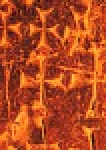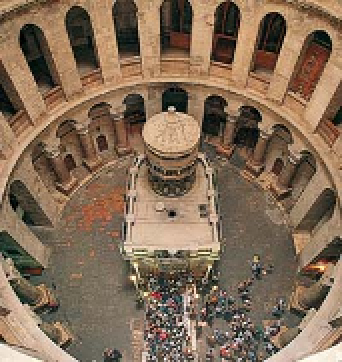Travel Reference
In-Depth Information
SITE OF CHRIST'S TOMB
In the first century AD, this site
consisted of a small, rocky rise
just outside the city walls and
a disused stone quarry into
whose rock face tombs had
been cut
The hillside
was dug
away in the 4th century
to allow a church to be
built around the tomb.
CHRIST'S TOMB
The present-day shrine around
the tomb of Christ was built
in 1809-10, after the severe
fire of 1808. It replaced one
dating from 1555, commis-
sioned by the Franciscan friar
Bonifacio da Ragusa. Before
that, there had been a succes-
sion of shrines replacing the
original 4th-century one de-
stroyed by the sultan Hakim
in 1009. Constantine's builders
had dug away the hillside to
leave the presumed rock-hewn
tomb of Christ isolated and
with enough room to build a
church around it. They had
also had to clear the remains
of an AD 135 Hadrianic temple
from the site, as well as the
material with which an old
quarry had been filled to
provide the temple's founda-
tions. In so doing, the Rock
of Golgotha was also found.
Today the shrine, owned by
the Greek, Armenian, Coptic,
and Roman Catholic commu-
nities, contains two chapels.
The outer Chapel of the Angel
has a low pilaster incorporat-
ing a piece of the stone said
to have been rolled from the
mouth of Christ's Tomb by
angels. It serves as a Greek Or
Burial chambers
existed
here in the 1st centuries
In the Coptic chapel behind
the shrine, a piece of polished
stone is shown as being part of
the tomb itself, but it is granite
and not limestone, as the
tomb here is known to be.
CHAPELS OF ST HELENA
AND THE INVENTIO
CRUCIS
From the ambulatory in the
Crusader-period apse, now
the choir in the Greek Catholi-
kon, steep steps lead down to
St Helena's Chapel. The crosses
on the walls were carved by
pilgrims. Although this crypt
was built by the Cru-
saders, who reused
Byzantine columns, the
side walls are, in fact,
foundations of the 4th-
century basilica. More
stairs go down to the
Inventio Crucis (Finding
of the Cross) Chapel, a
former cistern, in which
St Helena is said to
have found the True Cross. The
statue of her is 19th century.
ROTUNDA AND
SYRIAN CHAPEL
The Rotunda is built in
Classical Roman style.
The outer back wall
(now hidden by
interior partitions)
survives from the 4th-
century basilica up to a
height of 11 m (36 ft).
The 11th-century dome
was replaced after the
1808 fire and the two-
storey colonnade built.
The first two columns on the
right, standing with your back
to the nave, are replicas of two
that survived the fire, but were
judged unstable. The
originals were made
in the 11th century
from the two halves
of a single, gigantic
Roman column -
part either of the
4th-century basilica
or of the previous
Hadrianic temple.
In the Rotunda's
back wall is the
Syrian Chapel. It
contains Jewish rock
tombs (c.100 BC-
AD 100), marking
the limit to which
the hillside was dug
away when the first
church was built.
thodox altar. A low door leads
A
to the tiny inner Chapel of the
Holy Sepulchre with the 14th
Station of the Cross. A marble
A
slab covers the place where
Christ's body was supposedly
laid. The slab was installed
here in the 1555 reconstruc-
tion and purposely cracked to
deter Ottoman looters.
Carvings in St
Helena's Chapel
ETHIOPIAN MONASTERY
This simple monastery is
approached either through
the Coptic chapel in the corner
of the courtyard, to the right of
the main entrance, or from
Souk Khan el-Zeit
(see p91)
,
up steps beside Zalatimo's,
a famous pastry shop.
It occupies a series of small
buildings on the roof of St
Helena's Chapel, among the
ruins of the former Crusader
cloister. The Ethiopians were
forced up here in the 17th
century, when, unable to pay
Ottoman taxes, they lost
ownership of their chapels in
the main church to the Copts.
People queuing to enter the shrine containing
Christ's Tomb in the church's Rotunda
View of the Holy Sepulchre church from the roof of St Helena's Chapel



































